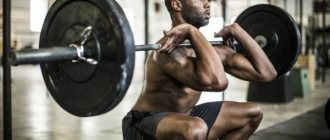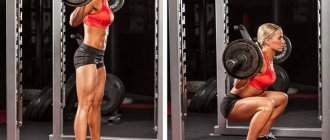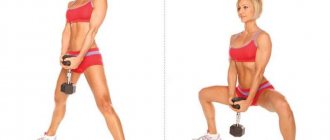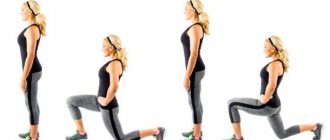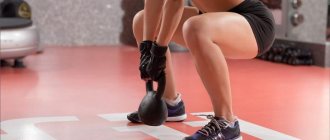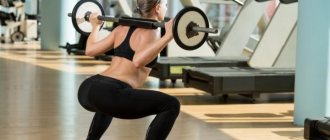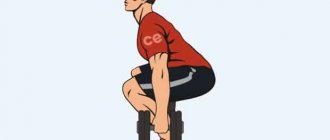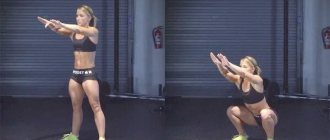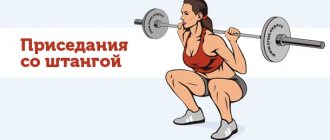Benefits and disadvantages
The exercise refers to narrowly focused techniques or variations of squats. The main purpose of performing a squat when the legs are narrow is to shift the load. In this case, the tension switches to the quadriceps (outer side). This makes this style of squats useful for creating the so-called “breeches,” which has long been an indicator of athletic fitness and physical development not only in men, but also in women. Also, such squats help improve the relief, and due to targeted pumping of the quadriceps (with a moderate diet), you can achieve pronounced separation in the hips.
The main advantages of the movement:
- Pumping the outer thighs (breeches).
- The best workout for the glutes.
- The ability to effectively work the quadriceps using lighter weights (for example, in case of problems with the spine, when excessive axial load is contraindicated).
- Improved balance and coordination.
- Development of flexibility.
- Improving the definition of the thighs.
The exercise has one drawback , and it prevents you from doing narrow squats with a barbell in a movement for constant progression (on a par with the classic squat). We are talking about increased load on the knee joints, which almost eliminates working with heavy weights for a long time. Therefore, a squat with a narrow leg position is used for a short time, in certain microcycles and no more than 6-8 weeks.
Initial position
Stand in front of the machine, place your hands slightly above your shoulders. Then you stand under the bar and place the bar on your trapeze. The shoulder blades should be retracted. Under no circumstances should you put it on your neck! See below picture
Your back should ALWAYS be straight, to do this you just need to look straight ahead, do not look at the floor. There are three foot positions, depending on your goal.
If you place your feet wide and point your toes out 45 degrees, the emphasis is on your heels and the outside of your feet. Since you have placed your legs wide, the maximum number of muscles is involved in the work, and the inner surface of the thigh is also involved.
Yes, that same problematic women's area! Since you are in the Smith machine, it removes some of the load, and it also prevents you from losing your balance. In this case, you will be able to go as low as possible, tilt your body, and thereby our gluteal muscles will be involved in the work.
The gluteal muscle and the inner thighs work mainly here. You need to sit lower than parallel, but to begin with, the correct execution is up to parallel with the floor!
The lower you squat, the better; your knees should not wander to the sides, they should be fixed and pointing to the sides along with your toes. If your knees are moving, you've put too much weight on yourself. It’s better to put less weight, but perform a technically high-quality exercise!
To properly perform squats on a Smith machine for women, you do not need to bend your knees, but move your hip joint back.
That is, you move your pelvis back, arching your back a little. There is no load on the lower back in this exercise, since you are performing the exercise in a Smith machine, and it is fixed. And you focus your work on the gluteal muscles.
This exercise is very suitable for beginners, because the exercise is controlled! There is another way to position your legs, this is when you bring your legs forward.
We place our legs in front about a step from the vertical line of the barbell. This should be done in order to reduce the load on the knee joints when doing a deep squat! At the same time, you will work out your buttocks well through a deep squat.
The lower back is not heavily loaded yet. The further you move your legs forward, the load is removed from the quadriceps and transferred to the gluteal muscles. And the outer thighs are also included in the work.
In this type of exercise, the load will go to the gluteal muscles, and this will happen due to the fact that you will lower yourself low, thereby stretching the gluteal muscles more. Try to go as low as possible, as far as you can.
And you should rise to the top without straightening your knees, you don’t need to insert them. They should be slightly bent so that the load on the knees is maintained. When we rise we exhale, when we descend we inhale, under no circumstances should you hold your breath!!!
There is another way to perform the squat exercise on a Smith machine for women. This is a classic squat.
Starting position - legs slightly wider than shoulders, bring your legs to the front and begin to squat. This type of squat is classic; the buttocks and quadriceps work here.
The rules are exactly the same in terms of the amplitude of movement, we don’t go all the way up, go down as low as possible. Elbows should point down. The exercise can be performed with different amplitudes. Rest on your heels, on the outside of your feet. This way the gluteal muscles are maximally involved in the work.
Dear girls, do not forget to train your legs regularly. Then you will get beautiful, toned, slender legs! Which of course everyone will be looking at! And that's all for me.
All the best! Be strong!
What muscles work
Narrow leg stance uses the same muscles that work during classic squats, these are:
- Quadriceps.
- Gluteal.
- Biceps femoris.
- Adductor muscles of the thigh.
- Calf.
- Soleus muscle.
If your legs are narrow to each other, then the load will mainly go to the quadriceps, especially the lateral head. The gluteus medius and minimus are also better involved in the work, but only if the squat is performed until the thigh is parallel to the floor and below.
Squat technique with a barbell on the shoulders (classic squats)
This is an extremely important question, friends!
It is when performing squats with a barbell on the shoulders that the cost of error is extremely high. I can't even imagine a more dangerous exercise in bodybuilding.
Although, any exercise can become dangerous if you turn off your brain. Figuratively speaking, naturally.
Starting from ruptures of the spinal extensors, to fractures of the neck, knee joints and death (!). All this can happen if a person “put” on technique from the very beginning of his training.
That is why I ALWAYS advise that the first two to three months be paid attention to the MOST IMPORTANT period in a person’s entire future training life - the period of preparation for further hypertrophy. Without this, everything can, sooner or later, end very badly
Without this, everything can, sooner or later, end very badly.
There is still a chance of injury, it still remains, but you significantly reduce the risk if you perform the exercises with perfect technique.
So, how to do squats correctly:
We approach the squat rack (as a rule, there are limiters there, install them, they give additional confidence). We grab the bar slightly wider than shoulder width. Place the bar just above the delts and just below the trapezoid. Strain and straighten your back, remove the bar from the racks
Attention: While performing squats, your feet must be pressed to the floor ENTIRELY!!! There should be no calf raises!!! We keep our heads either straight or look up. This will allow us to keep our back straight at every point of the amplitude! We place our feet slightly wider than our shoulders, with our toes pointing forward (you can turn them outward by 15-20 degrees). The back is straight, the head looks straight or up, we begin to bend the legs. We squat either until our thighs are parallel to the floor, or slightly lower. WE FEEL THE CONTRACTION AND TENSION OF OUR QUADRICEPS, we begin to move upward. We strain our quadriceps, straight back, look up or straight, stand up, constantly thinking about how the quadriceps feel
You must feel them AT EVERY POINT OF AMPLITUDE, otherwise, otherwise, the load may not hit the target exactly, but will “spread” over the back, buttocks and other muscles.
The simplest manipulations with squats:
- BREAK YOUR LEGS WIDER = the inner thighs work harder.
- BRINGING THE LEGS ALREADY = the lateral (outer) heads of the quadriceps are more involved in the work.
- LEANING A LITTLE STRONGER FORWARD = emphasis shifts to the gluteal muscles.
- KEEP YOUR BACK EVEN = the load falls on the quadriceps.
- TURN YOUR FEET OUTSIDE = shift the load to the lateral heads of the quadriceps.
- FEET STRAIGHT = load is distributed evenly across all heads of the quadriceps (lateral, medial, rectus and intermediate).
Under no circumstances should you:
- Push your knees forward beyond your toes. This can lead to rupture of ligaments, menisci and other unpleasant consequences.
- Bend your back at any point of the amplitude. If this trick is performed with a large enough weight, then you will have to say goodbye to barbell squats forever, and to normal training too. Can lead to rupture of spinal extensors, vertebral injuries, etc.
- Lean back too much. This will lead to a simple loss of balance and, most likely, injury.
These are the most classic squats, with which you can grow very impressive leg muscles.
Barbell technique
Barbells and free weights are not the best choice for performing narrow-set squats. This is due to the fact that with this position of the legs it is much more difficult to maintain balance, especially if you want to sit quite low.
Technique:
- Remove the barbell from the supports, place the bar behind your back, on your rear delts, just below your neck.
- Place your feet at shoulder level (not close together), this is the starting position.
- Sit down with your back straight as low as possible.
- Without pausing, return to the starting position at a slightly faster pace.
It is important to ensure that the depth of the squat does not lead to rounding of the back. For a lower squat, it is recommended to additionally perform a complex of stretches, this will increase mobility and flexibility.
Features of squats with a barbell for women
Squats on a Smith machine for women are not just a way to pump up your legs, but also to get a soft and firm butt.
The starting position is to stand in front of the machine, place your hands slightly wider than your shoulders, dive under the barbell and place it on the trapezius. Not on the neck, not lower - only on the trapezoid. Otherwise, you'll just break your neck or drop the barbell. The back is straight. If you don't know whether you are holding it straight, just look at the ceiling, then automatically you will straighten up.
During the approach, you do not need to look at the floor, otherwise you will lose coordination of movements. Optimally - in the upper corner in front of you. This applies not only to squats in the Smith machine, but also to regular exercises.
About the correct position of the feet
There are 3 positions, depending on your goals.
- Wide stance of the legs at an angle of 45 degrees, legs pointing towards the knees. The emphasis is on the heels and the outer side of the foot. You should squat deeper than parallel, your knees are strictly fixed and pointing towards your toes. By doing this you will achieve maximum work of all muscles + connection of the inner thigh. You can also bend at optimal angles and use your gluteal muscles.
- The legs are brought forward, the further, the more the load is removed from the quadriceps and transferred to the gluteal parts, in addition, you connect the outer surface of the thighs. There is a nuance here - you need to squat as low as possible, but it is highly undesirable to fully extend your knees. We lower ourselves as we inhale and rise as we exhale. The spine is straight, we always look straight. Initially, it is better to squat to parallel to get comfortable with the technique, then you can go a little deeper. A slight burning sensation in the muscles will indicate that the exercise is performed correctly.
- Allows you to systematically develop all muscle groups, without focusing on working out any specific lagging group. In this version, the legs are placed slightly wider than the shoulders, the legs are brought forward and squats are performed until the legs are parallel to the floor. This way, you will achieve optimal hip and quadriceps function.
But this is one side of the coin. It is no secret that the structure of the body in women is more complex than in men. Accordingly, mistakes can lead to complications and problems in the future.
We've looked at the intricacies of squats on the Smith machine for women, and now let's talk about men.
Inventory options
Like regular squats, “narrow” squats can be done with any equipment and machines. The Smith machine is considered the most optimal. Fixing the barbell eliminates the main problem with free weights – the possibility of losing balance, which makes the exercise completely safe. Also, with this option, some stabilizing muscles are turned off. This is very useful when it comes to focused pumping of specific muscle areas.
The Smith technique is similar to the barbell version. Moreover, in Smith you can place your feet close together without the risk of falling backwards.
The option with dumbbells is not as convenient, but it is well suited for home conditions, where there are usually no other exercise machines or equipment. Dumbbells can be “thrown” onto your shoulders, which is more like a front squat. However, this technique will help you balance your weight better and reduce the risk of falling backwards. Also, the option with dumbbells allows you to perform perhaps the deepest squat, given the location of the weight.
How to implement it into training
The narrow-foot squat is a highly specialized movement. It is not recommended to do it in the same workout as classic squats. The most convenient implementation methods are usually:
- Perform on an ongoing basis once every 2-3 weeks.
- Performing only “narrow” squats for 6-8 weeks or one training cycle.
- During a workout, it is enough to do 3-4 working approaches, especially if the last of them is failure or pre-failure.
- The repetition mode will depend on the goals and other conditions. But this type of squat works great both with a low number of repetitions (6-8) and in a high-repetition mode (12-20). Doing more than 20 repetitions is not recommended due to the stress on the knee joints.
And also read: How to do front squats with a barbell → Squats with dumbbells: technique and variations → Classic squats with a barbell →
Sumo squat technique Bomb body
The correct technique for performing a squat with a wide stance, tips, tricks and training videos from fitness and bodybuilding experts are described.
Description of the exercise
Like the sumo deadlift, its name comes from the wide-set legs that require a certain amount of hip flexibility to perform. Start performing the muscles after stretching the inner thigh, this is necessary so that the knees point strictly towards the toes, otherwise under load and an uncomfortable position, the risk of knee injury increases.
This exercise is not for dummies, so do it after mastering the basic barbell squat technique.
Muscles trained
The main load is on the adductor and gluteal muscles, partly the quadriceps and a small part of the hamstrings receive the load.
Exercise technique
1
The first and most important rule is that you need to start sumo squats after a good stretch of the adductor muscles of the leg and with sufficient flexibility in the hip joint, otherwise injury will quickly creep up on you
2. Widely spaced legs are aimed at good pumping of the inner thighs.
3. The lower the squat, the more effective the exercise, but watch your knees carefully; if they begin to move away from the direction where your toes are pointing, moving towards the center, stop.
4. It is necessary to control the width of your legs, place them in such a way that you can sit parallel to the floor, otherwise you will not fully use the effectiveness of the exercise.
5. Do not load the barbell to the limit, these are not exercises for records, usually the working weight is 20-30% of regular squats and this is normal, the weights are set in such a way that you perform at least 6-8 repetitions without violating the movement technique.
